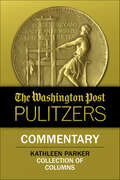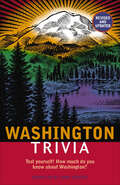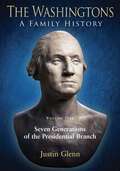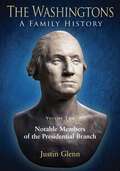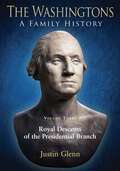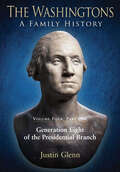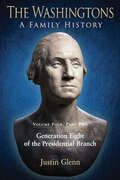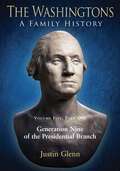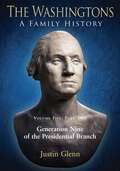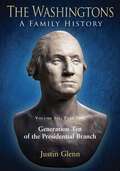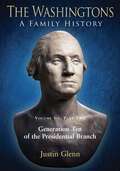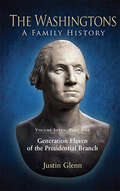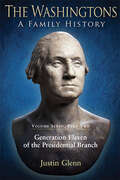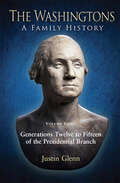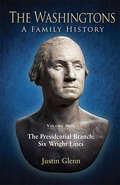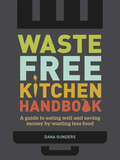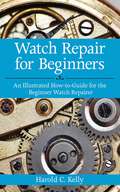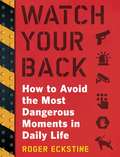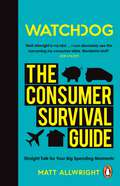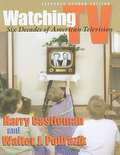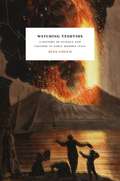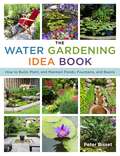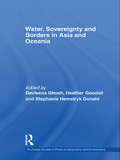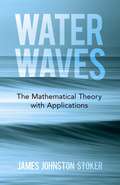- Table View
- List View
The Washington Post Pulitzers: Commentary, Kathleen Parker
by Kathleen ParkerRecipient of the Pulitzer Prize for Commentary. Kathleen Parker, former staff writer for the Orlando Sentinel and author of SAVE THE MALES: WHY MEN MATTER, WHY WOMEN SHOULD CARE, informs and astounds readers with her Pulitzer Prize-winning columns for The Washington Post. No subject too charged or controversial; Parker tackles topics as incendiary as abortion, as charged as race, as current as President Obama, as deceptively whimsical as Twitter. Shaped by wisdom, originality, and good, old-fashioned reporting, Kathleen Parker never fails to leave her readers entertained and enlightened.
Washington Trivia: Revised Edition
by John HedtkeTest your knowledge of the Evergreen State with this revised and updated trivia book covering its history, geography, sports, culture, and more!Known for Seattle’s Space Needle, spectacular mountains, innovative technology, and outdoor adventure, the state of Washington is celebrated in Washington Trivia. Here the reader can find out what Washington city elects an official grouch each year, what started the Spokane fire of 1889, and for what wrongdoing the first automobile owner in Clark County was cited.
The Washingtons. Volume 1: Seven Generations of the Presidential Branch (The Washingtons: A Family History #1)
by Justin GlennThis is the initial volume of a comprehensive history that traces the “Presidential line” of the Washingtons. Volume one begins with the immigrant John Washington who settled in Westmoreland Co., Va., in 1657, married Anne Pope, and was the great-grandfather of President George Washington. This volume continues the story of John and Anne’s family for a total of seven generations, collecting over 5,000 direct descendants. Future volumes will trace eight more generations with a total of over 63,000 descendants. Although structured in a genealogical format for the sake of clarity, this is no bare bones genealogy but a true family history with over 1,200 detailed biographical narratives. These in turn strive to convey the greatness of the family that produced not only The Father of His Country but many others, great and humble, who struggled to build that country. The Washingtons includes the time-honored John Wright line which in recent years has been challenged largely on the basis of DNA evidence. Volumes one and two will form a set, with a cumulative bibliography appearing at the end of volume 2. Volume two will highlight the most notable descendants and spouses from the later volumes, including such luminaries as General George S. Patton, the author Shelby Foote, and the actor Lee Marvin. All of the volumes, now estimated at fourteen in all, are virtually complete and are scheduled for release over the course of the next year.
The Washingtons. Volume 2: Notable Members of the Presidential Branch (The Washingtons: A Family History #2)
by Justin GlennThis is the second volume of a comprehensive history that traces the “Presidential line” of the Washingtons. Volume one began with the immigrant John Washington who settled in Westmoreland Co., Va., in 1657, married Anne Pope, and was the great-grandfather of President George Washington. It continued the record of their descendants for a total of seven generations. Volume two is a collection of notable descendants of the next eight generations of John and Anne Washington’s descendants, including such luminaries as General George S. Patton, the author Shelby Foote, and the actor Lee Marvin. Future volumes will trace generations eight through fifteen, making a total of over 63,000 descendants. Although structured in a genealogical format for the sake of clarity, this is no bare bones genealogy but a true family history with over 1,200 detailed biographical narratives. These in turn strive to convey the greatness of the family that produced not only The Father of His Country but many others, great and humble, who struggled to build that country. The Washingtons includes the time-honored John Wright line which in recent years has been challenged largely on the basis of DNA evidence. Volumes one and two form a set, with a cumulative bibliography appearing at the end of volume two.
The Washingtons. Volume 3: Royal Descents of the Presidential Branch (The Washingtons: A Family History #3)
by Justin GlennThis Royal Descents supplement is an outgrowth of the author’s multi-volume family history of the “Presidential Branch” of the Washingtons. That work collects the descendants of the immigrant John Washington who settled in Westmoreland Co., Va., in 1657, married Anne Pope, and became the great-grandfather of President George Washington. The Royal Descents traces the ancestry of the early Virginia members of this “Presidential Branch” back in time to the aristocracy and nobility of England and continental Europe, including the Plantagenet dynasty, William the Conqueror, Alfred the Great, Charles Martel, and Charlemagne. ADVANCE PRAISE for The Washingtons: A Family History “I am convinced that your work will be of wide interest to historians and academics as well as members of the Washington family itself. Although the surname Washington is perhaps the best known in American history and much has been written about the Washington family for well over a century, it is surprising that no comprehensive family history has been published. Justin M. Glenn’s The Washingtons: A Family History finally fills this void for the branch to which General and President George Washington belonged, identifying some 63,000 descendants. This is truly a family history, not a mere tabulation of names and dates, providing biographical accounts of many of the descendants of John Washington who settled in Westmoreland County, Virginia, in 1657. . . . Each individual section is followed by extensive listings of published and manuscript sources supporting the information presented and errors of identification in previous publications are commented upon as appropriate.” John Frederick Dorman, editor of The Virginia Genealogist (1957-2006) and author of Adventurers of Purse and Person “Decades of reviewing Civil War books have left me surprised and delighted when someone applies exhaustive diligence to a topic not readily accessible. Dr. Glenn surely meets that standard with the meticulous research that unveils the Washington family in gratifying detail—many of them Confederates of interest and importance.” Robert K. Krick, author of The Smoothbore Volley that Doomed the Confederacy and Stonewall Jackson at Cedar Mountain
The Washingtons. Volume 4, Part 1: Generation Eight of the Presidential Branch (The Washingtons: A Family History #4.2)
by Justin GlennThis is the fourth volume of Dr. Justin Glenn’s comprehensive history that traces the “Presidential line” of the Washingtons. Volume One began with the immigrant John Washington, who settled in Westmoreland Co., Va., in 1657, married Anne Pope, and became the great-grandfather of President George Washington. It continued the record of their descendants for a total of seven generations. Volume Two highlighted notable members of the next eight generations of John and Anne Washington’s descendants, including General George S. Patton, author Shelby Foote, and actor Lee Marvin. Volume Three traced the ancestry of the early Virginia members of this “Presidential Branch” back in time to the aristocracy and nobility of England and continental Europe. Volume Four resumes the family history where Volume One ended. It presents Generation Eight of the immigrant John Washington’s descendants, containing nearly 7,000 descendants. Future volumes will trace generations nine through fifteen, making a total of over 63,000 descendants. Although structured in a genealogical format for the sake of clarity, this is no bare bones genealogy but a true family history with over 1,200 detailed biographical narratives. These in turn strive to convey the greatness of the family that produced not only The Father of His Country but many others, great and humble, who struggled to build that country. Volume Four, Part One covers the descendants of the immigrant John Washington’s child Lawrence Washington. Volume Four, Part Two covers the descendants of the Immigrant’s children John Washington, Jr., and Anne (Washington) Wright.
The Washingtons. Volume 4, Part 2: Generation Eight of the Presidential Branch (The Washingtons: A Family History #4.2)
by Justin GlennThis is the fourth volume of Dr. Justin Glenn’s comprehensive history that traces the “Presidential line” of the Washingtons. Volume One began with the immigrant John Washington, who settled in Westmoreland Co., Va., in 1657, married Anne Pope, and became the great-grandfather of President George Washington. It continued the record of their descendants for a total of seven generations. Volume Two highlighted notable members of the next eight generations of John and Anne Washington’s descendants, including General George S. Patton, author Shelby Foote, and actor Lee Marvin. Volume Three traced the ancestry of the early Virginia members of this “Presidential Branch” back in time to the aristocracy and nobility of England and continental Europe. Volume Four resumes the family history where Volume One ended. It presents Generation Eight of the immigrant John Washington’s descendants, containing nearly 7,000 descendants. Future volumes will trace generations nine through fifteen, making a total of over 63,000 descendants. Although structured in a genealogical format for the sake of clarity, this is no bare bones genealogy but a true family history with over 1,200 detailed biographical narratives. These in turn strive to convey the greatness of the family that produced not only The Father of His Country but many others, great and humble, who struggled to build that country. Volume Four, Part One covers the descendants of the immigrant John Washington’s child Lawrence Washington. Volume Four, Part Two covers the descendants of the Immigrant’s children John Washington, Jr., and Anne (Washington) Wright.
The Washingtons. Volume 5, Part 1: Generation Nine of the Presidential Branch (The Washingtons: A Family History #5.1)
by Justin GlennThis is the fifth volume of Dr. Justin Glenn’s comprehensive history that traces the “Presidential line” of the Washingtons. Volume One began with the immigrant John Washington, who settled in Westmoreland Co., Va., in 1657, married Anne Pope, and became the great-grandfather of President George Washington. It continued the record of their descendants for a total of seven generations. Volume Two highlighted notable family members in the next eight generations of John and Anne Washington’s descendants, including such luminaries as General George S. Patton, the author Shelby Foote, and the actor Lee Marvin. Volume Three traced the ancestry of the early Virginia members of this “Presidential Branch” back in time to the aristocracy and nobility of England and continental Europe. Volume Four resumed the family history where Volume One ended, and it contained Generation Eight of the immigrant John Washington’s descendants. Volume Five now presents Generation Nine, including more than 10,000 descendants. Future volumes will trace generations ten through fifteen, making a total of over 63,000 descendants. Although structured in a genealogical format for the sake of clarity, this is no bare bones genealogy but a true family history with over 1,200 detailed biographical narratives. These in turn strive to convey the greatness of the family that produced not only The Father of His Country but many others, great and humble, who struggled to build that country. ADVANCE PRAISE “I am convinced that your work will be of wide interest to historians and academics as well as members of the Washington family itself. Although the surname Washington is perhaps the best known in American history and much has been written about the Washington family for well over a century, it is surprising that no comprehensive family history has been published. Justin M. Glenn’s The Washingtons: A Family History finally fills this void for the branch to which General and President George Washington belonged, identifying some 63,000 descendants. This is truly a family history, not a mere tabulation of names and dates, providing biographical accounts of many of the descendants of John Washington who settled in Westmoreland County, Virginia, in 1657. . . . Each individual section is followed by extensive listings of published and manuscript sources supporting the information presented and errors of identification in previous publications are commented upon as appropriate.” John Frederick Dorman, editor of The Virginia Genealogist (1957-2006) and author of Adventurers of Purse and Person “Decades of reviewing Civil War books have left me surprised and delighted when someone applies exhaustive diligence to a topic not readily accessible. Dr. Glenn surely meets that standard with the meticulous research that unveils the Washington family in gratifying detail—many of them Confederates of interest and importance.” Robert K. Krick, author of The Smoothbore Volley that Doomed the Confederacy and Stonewall Jackson at Cedar Mountain
The Washingtons. Volume 5, Part 2: Generation Nine of the Presidential Branch (The Washingtons: A Family History #5.1)
by Justin GlennThis is the fifth volume of Dr. Justin Glenn’s comprehensive history that traces the “Presidential line” of the Washingtons. Volume One began with the immigrant John Washington, who settled in Westmoreland Co., Va., in 1657, married Anne Pope, and became the great-grandfather of President George Washington. It continued the record of their descendants for a total of seven generations. Volume Two highlighted notable family members in the next eight generations of John and Anne Washington’s descendants, including such luminaries as General George S. Patton, the author Shelby Foote, and the actor Lee Marvin. Volume Three traced the ancestry of the early Virginia members of this “Presidential Branch” back in time to the aristocracy and nobility of England and continental Europe. Volume Four resumed the family history where Volume One ended, and it contained Generation Eight of the immigrant John Washington’s descendants. Volume Five now presents Generation Nine, including more than 10,000 descendants. Future volumes will trace generations ten through fifteen, making a total of over 63,000 descendants. Although structured in a genealogical format for the sake of clarity, this is no bare bones genealogy but a true family history with over 1,200 detailed biographical narratives. These in turn strive to convey the greatness of the family that produced not only The Father of His Country but many others, great and humble, who struggled to build that country. ADVANCE PRAISE “I am convinced that your work will be of wide interest to historians and academics as well as members of the Washington family itself. Although the surname Washington is perhaps the best known in American history and much has been written about the Washington family for well over a century, it is surprising that no comprehensive family history has been published. Justin M. Glenn’s The Washingtons: A Family History finally fills this void for the branch to which General and President George Washington belonged, identifying some 63,000 descendants. This is truly a family history, not a mere tabulation of names and dates, providing biographical accounts of many of the descendants of John Washington who settled in Westmoreland County, Virginia, in 1657. . . . Each individual section is followed by extensive listings of published and manuscript sources supporting the information presented and errors of identification in previous publications are commented upon as appropriate.” John Frederick Dorman, editor of The Virginia Genealogist (1957-2006) and author of Adventurers of Purse and Person “Decades of reviewing Civil War books have left me surprised and delighted when someone applies exhaustive diligence to a topic not readily accessible. Dr. Glenn surely meets that standard with the meticulous research that unveils the Washington family in gratifying detail—many of them Confederates of interest and importance.” Robert K. Krick, author of The Smoothbore Volley that Doomed the Confederacy and Stonewall Jackson at Cedar Mountain
The Washingtons. Volume 6, Part 1: Generation Ten of the Presidential Branch (The Washingtons: A Family History #6.1)
by Justin GlennThis is the sixth volume of Dr. Justin Glenn’s comprehensive history that traces the “Presidential line” of the Washingtons. Volume One began with the immigrant John Washington, who settled in Westmoreland Co., Va., in 1657, married Anne Pope, and became the great-grandfather of President George Washington. It continued the record of their descendants for a total of seven generations. Volume Two highlighted notable family members in the next eight generations of John and Anne Washington’s descendants. Volume Three traced the ancestry of the early Virginia members of this “Presidential Branch” back to the aristocracy and nobility of England and continental Europe. Volume Four resumed the family history where Volume One ended, and it contained Generation Eight of the immigrant John Washington’s descendants. Volume Five treated Generation Nine. Volume Six now presents Generation Ten, and it includes over 12,000 descendants. Future volumes will add generations eleven through fifteen, making a total of over 63,000 descendants. Although structured in a genealogical format for the sake of clarity, this is no bare bones genealogy but a true family history with over 1,200 detailed biographical narratives. These in turn strive to convey the greatness of the family that produced not only The Father of His Country but many others, great and humble, who struggled to build that country. Volume Six, Part One covers the descendants of the Immigrant John Washington’s children Lawrence Washington and John Washington, Jr. Volume Six, Part Two covers the descendants of the Immigrant’s child Anne (Washington) Wright.
The Washingtons. Volume 6, Part 2: Generation Ten of the Presidential Branch (The Washingtons: A Family History #6.1)
by Justin GlennThis is the sixth volume of Dr. Justin Glenn’s comprehensive history that traces the “Presidential line” of the Washingtons. Volume One began with the immigrant John Washington, who settled in Westmoreland Co., Va., in 1657, married Anne Pope, and became the great-grandfather of President George Washington. It continued the record of their descendants for a total of seven generations. Volume Two highlighted notable family members in the next eight generations of John and Anne Washington’s descendants. Volume Three traced the ancestry of the early Virginia members of this “Presidential Branch” back in time to the aristocracy and nobility of England and continental Europe. Volume Four resumed the family history where Volume One ended, and it contained Generation Eight of the immigrant John Washington’s descendants. Volume Five treated Generation Nine. Volume Six now presents Generation Ten, and it includes over 12,000 descendants. Future volumes will add generations eleven through fifteen, making a total of over 63,000 descendants. Although structured in a genealogical format for the sake of clarity, this is no bare bones genealogy but a true family history with over 1,200 detailed biographical narratives. These in turn strive to convey the greatness of the family that produced not only The Father of His Country but many others, great and humble, who struggled to build that country. ADVANCE PRAISE “I am convinced that your work will be of wide interest to historians and academics as well as members of the Washington family itself. Although the surname Washington is perhaps the best known in American history and much has been written about the Washington family for well over a century, it is surprising that no comprehensive family history has been published. Justin M. Glenn’s The Washingtons: A Family History finally fills this void for the branch to which General and President George Washington belonged, identifying some 63,000 descendants. This is truly a family history, not a mere tabulation of names and dates, providing biographical accounts of many of the descendants of John Washington who settled in Westmoreland County, Virginia, in 1657. . . . Each individual section is followed by extensive listings of published and manuscript sources supporting the information presented and errors of identification in previous publications are commented upon as appropriate.” John Frederick Dorman, editor of The Virginia Genealogist (1957-2006) and author of Adventurers of Purse and Person “Decades of reviewing Civil War books have left me surprised and delighted when someone applies exhaustive diligence to a topic not readily accessible. Dr. Glenn surely meets that standard with the meticulous research that unveils the Washington family in gratifying detail—many of them Confederates of interest and importance.” Robert K. Krick, author of The Smoothbore Volley that Doomed the Confederacy and Stonewall Jackson at Cedar Mountain
The Washingtons. Volume 7, Part 1: Generation Eleven of the Presidential Branch (The Washingtons: A Family History #7.1)
by Justin GlennThis is the seventh volume of Dr. Justin Glenn’s comprehensive history that traces the “Presidential line” of the Washingtons. Volume one began with the immigrant John Washington, who settled in Westmoreland Co., Va., in 1657, married Anne Pope, and became the great-grandfather of President George Washington. It continued the record of their descendants for a total of seven generations. Volume two highlighted notable members of the next eight generations, including such luminaries as General George S. Patton, the author Shelby Foote, and the actor Lee Marvin. Volume three traced the ancestry of the early Virginia members of this “Presidential Branch” back to the royalty and nobility of England and continental Europe. Volumes four, five, and six treated respectively generations eight, nine, and ten. Volume Seven presents generation eleven, comprising more than 10,000 descendants of the immigrant John Washington. Although structured in a genealogical format for the sake of clarity, this is no bare bones genealogy but a true family history with over 1,200 detailed biographical narratives. These strive to convey the greatness of the family that produced not only The Father of His Country but many others, great and humble, who struggled to build that country. Volume Seven, Part One covers the descendants of the immigrant’s children Lawrence and John Washington, Jr. Volume Seven, Part Two covers the descendants of the immigrant’s child Anne (Washington) Wright.
The Washingtons. Volume 7, Part 2: Generation Eleven of the Presidential Branch (The Washingtons: A Family History #7.2)
by Justin GlennThis is the seventh volume of Dr. Justin Glenn’s comprehensive history that traces the “Presidential line” of the Washingtons. Volume one began with the immigrant John Washington, who settled in Westmoreland Co., Va., in 1657, married Anne Pope, and became the great-grandfather of President George Washington. It continued the record of their descendants for a total of seven generations. Volume two highlighted notable members of the next eight generations, including such luminaries as General George S. Patton, the author Shelby Foote, and the actor Lee Marvin. Volume three traced the ancestry of the early Virginia members of this “Presidential Branch” back to the royalty and nobility of England and continental Europe. Volumes four, five, and six treated respectively generations eight, nine, and ten. Volume Seven presents generation eleven, comprising more than 10,000 descendants of the immigrant John Washington. Although structured in a genealogical format for the sake of clarity, this is no bare bones genealogy but a true family history with over 1,200 detailed biographical narratives. These strive to convey the greatness of the family that produced not only The Father of His Country but many others, great and humble, who struggled to build that country. Volume Seven, Part One covers the descendants of the immigrant’s children Lawrence and John Washington, Jr. Volume Seven, Part Two covers the descendants of the immigrant’s child Anne (Washington) Wright.
The Washingtons. Volume 8: Generations Twelve to Fifteen of the Presidential Branch (The Washingtons: A Family History)
by Justin GlennThis is the eighth volume of Dr. Justin Glenn’s comprehensive history that traces the “Presidential line” of the Washingtons. Volume one began with the immigrant John Washington, who settled in Westmoreland Co., Va., in 1657, married Anne Pope, and became the great-grandfather of President George Washington. It continued the record of their descendants for a total of seven generations. Volume two highlighted notable members of the next eight generations, including such luminaries as General George S. Patton, the author Shelby Foote, and the actor Lee Marvin. Volume three traced the ancestry of the early Virginia members of this “Presidential Branch” back to the royalty and nobility of England and continental Europe. Volumes four, five, six, and seven treated respectively generations eight, nine, ten, and eleven. Volume Eight presents generations twelve through fifteen, comprising more than 8,500 descendants of the immigrant John Washington. Although structured in a genealogical format for the sake of clarity, this is no bare bones genealogy but a true family history with over 1,200 detailed biographical narratives. These strive to convey the greatness of the family that produced not only The Father of His Country but many others, great and humble, who struggled to build that country.
The Washingtons. Volume 9: The Presidential Branch: Six Wright Lines (The Washingtons: A Family History #9)
by Justin GlennThis is the ninth volume of a comprehensive history that traces the “Presidential Line” of the Washingtons. Volume one began with the immigrant John Washington who settled in Westmoreland Co., Va., in 1657, married Anne Pope, and was the great-grandfather of President George Washington. It contained the record of their descendants for a total of seven generations. Subsequent volumes two through eight continued this family history for an additional eight generations, highlighting most notable members (volume two) and tracing lines of descent from the royalty and nobility of England and continental Europe (volume three). Volume nine collects over 8,500 descendants of the recently discovered line of William Wright (died in Franklin Co., Va., ca. 1809). It also provides briefer accounts of five other early Wright families of Virginia that have often been mentioned by researchers as close kinsmen of George Washington, including: William Wright (died in Fauquier Co., Va., ca. 1805), Frances Wright and her husband Nimrod Ashby, and William Wright (died in Greensville Co., Va., by 1827). A cumulative index will complete the series as volume ten.
Waste-Free Kitchen Handbook: A Guide to Eating Well and Saving Money By Wasting Less Food
by Dana GundersThis &“slim but indispensable new guide&” offers &“practical tips and delicious recipes that will help reduce kitchen waste and save money&” (The Washington Post). Despite a growing awareness of food waste, many well-intentioned home cooks lack the tools to change their habits. This handbook—packed with engaging checklists, simple recipes, practical strategies, and educational infographics—is the ultimate tool for using more and wasting less in your kitchen. From a scientist at the Natural Resources Defense Council come these everyday techniques that call for minimal adjustments of habit, from shopping, portioning, and using a refrigerator properly to simple preservation methods including freezing, pickling, and cellaring. At once a good read and a go-to reference, this handy guide is chock-full of helpful facts and tips, including twenty &“use-it-up&” recipes and a substantial directory of common foods.
Watch Repair for Beginners: An Illustrated How-To Guide for the Beginner Watch Repairer
by Harold C. KellyFirst written by the definitive expert in 1957, Watch Repair for Beginners is the ideal book for anyone who wants to know how to fix their own watch. Learn what horology is; the basics of watch and clock repairing; the mechanics of a clock; how the wheels work; the difference between an automatic watch, a stop watch, and a chronograph; and so much more. With detailed black-and-white illustrations, this timeless classic is a must-have addition to any horology lover's collection.
Watch Your Back: How to Avoid the Most Dangerous Moments in Daily Life
by Roger EckstineConcrete Strategies for Staying Safe and Protecting Yourself from AssailantsDo you ever feel the urge to furtively look over your shoulder to check if someone’s following you? Have you second-guessed a decision to walk in a poorly lit area late at night? When you see crime reports on the news, do you ever wonder if it could happen to you? Every day, unsuspecting people fall victim to muggers, pickpockets, carjackers, and other criminals. What can you do to make sure you’re not one of them?In Watch Your Back, Roger Eckstine presents dozens of possible risky scenarios that can occur in daily life and ways to counteract each threat. Potential hazards include:Paying for gas at the pumpUsing the ATMRoad rage and the belligerent fender benderAn active shooter attackConcealed carry and the rigors of daily lifeAnd much more!Eckstine illustrates his points by referencing case studies and news clippings of real-life events. He describes various ways people can be prepared both mentally and physically for altercations, with an emphasis on training yourself to constantly observe your surroundings. Additionally, he suggests emergency devices, personal weaponry, and communication tools to help in dangerous situations. You and your loved ones deserve to feel safe all the time. Watch Your Back has the advice you need to make this happen.
Watchdog: The Consumer Survival Guide
by Matt Allwright'Matt Allwright is my idol. As a comic I'm supposed to say something funny about this book, but actually it's legit useful, helpful advice, written compassionately and clearly. I can absolutely see this becoming my consumer bible. Wonderful stuff!' - JOE LYCETT'Every scam, rogue trader or poor excuse for shoddy service...Watchdog's seen them all. And leading the troops is the consumer superhero who has faced and fought every dodgepot going. Our Matt always has your back, whether he's wearing his cape or not.' - STEPH MCGOVERN'Finally! A book that puts all the info in one place AND makes it funny. Matt is the best at this - making difficult stuff easy to swallow so that we can fight our own corners when he isn't there to fight them for us.' - GABY ROSLINKeep your money in your pocket.In Watchdog: The Consumer Survival Guide, Matt Allwright will help you to help yourself amid the minefield of modern consumer rights and fraudsters, offering practical advice on how to sidestep pitfalls in all areas of life. Each chapter is built around relatable hurdles we all face - renting a flat, buying a car, securing our online data, booking a dream holiday and much more.Packed with useful tips, myth busters and case studies, Watchdog: The Consumer Survival Guide will leave you feeling empowered and save you some pennies along the way.
Watching TV: Six Decades of American Television (Expanded Second Edition)
by Harry Castleman Walter J. PodrazikWatching TV provides a fascinating history of how the personalities, popular shows, and coverage of key events have evolved during the past six decades. Watching TV is the standard history of American television, now updated to include the most recent programming and industry developments.
Watching Vesuvius: A History of Science and Culture in Early Modern Italy
by Sean CoccoMount Vesuvius has been famous ever since its eruption in 79 CE, when it destroyed and buried the Roman cities of Pompeii and Herculaneum. But less well-known is the role it played in the science and culture of early modern Italy, as Sean Cocco reveals in this ambitious and wide-ranging study. Humanists began to make pilgrimages to Vesuvius during the early Renaissance to experience its beauty and study its history, but a new tradition of observation emerged in 1631 with the first great eruption of the modern period. Seeking to understand the volcanoOCOs place in the larger system of nature, Neapolitans flocked to Vesuvius to examine volcanic phenomena and to collect floral and mineral specimens from the mountainside. aIn "Watching Vesuvius," Cocco argues that this investigation and engagement with Vesuvius was paramount to the development of modern volcanology. He then situates the native experience of Vesuvius in a larger intellectual, cultural, and political context and explains how later eighteenth-century representations of NaplesOCoof its climate and characterOCogrew out of this tradition of natural history. Painting a rich and detailed portrait of Vesuvius and those living in its shadow, Cocco returns the historic volcano to its place in a broader European culture of science, travel, and appreciation of the natural world.
The Water Gardening Idea Book: How to Build, Plant, and Maintain Ponds, Fountains, and Basins
by Peter BissetLearn how to transform an ordinary backyard garden into a true showpiece. Originally published in 1924, Peter Bisset shares with readers timeless advice and tips for creating a variety of water gardens. After experiencing one, it's easy to see why these gardens hold such appeal; these splashing fountains and ponds make hot days seem cooler, and they also attract birds and butterflies to your backyard. Even tiny tabletop fountains offer soothing sounds to drown out a busy street or a noisy neighbor.The Water Gardening Idea Book gives in full detail all the practical information necessary for the selection, grouping, and successful cultivation of aquatic and other plants required in the making of a water garden and its surroundings. It's perfect for both amateurs and those with green thumbs looking to take their gardens to the next level. Readers will enjoy projects of varying difficulty, starting with simple container gardens to the large estate or park fountains and ponds. Whether you're interested in creating a casual pond or a formal fountain, with The Water Gardening Idea Book you'll be able to create them with confidence.
Water, Sovereignty and Borders in Asia and Oceania (Routledge Studies in Physical Geography and Environment)
by Stephanie Donald Devleena Ghosh Heather GoodallThis book restores water, both fresh and salt, to its central position in human endeavour, ecology and environment. Water access and the environmental and social problems of development are major issues of concern in this century. Drawing on water's many formations in debating human relationship with a major source of life and a major factor in contemporary politics, this book covers oceans and rivers to lagoons, billabongs and estuaries in Asia, Oceania and the West Pacific. In an interdisciplinary and cross-disciplinary analysis of the water problem, the contributors address the physical descriptors of water and water flow, and they interrogate the politicised administrations of water in closely corresponding regions. Water, Sovereignty and Borders in Asia and Oceania identifies new discursive possibilities for thinking about water in theory and in practice. It presents those discourses that seem most useful in addressing the multiple crises the region is facing and thus should be of interest to scholars of Asian Studies, Geography, Environmental and Cultural Studies.
Water Waves: The Mathematical Theory With Applications (Dover Books on Physics)
by James Johnston StokerFirst published in 1957, this is a classic monograph in the area of applied mathematics. It offers a connected account of the mathematical theory of wave motion in a liquid with a free surface and subjected to gravitational and other forces, together with applications to a wide variety of concrete physical problems. A never-surpassed text, it remains of permanent value to a wide range of scientists and engineers concerned with problems in fluid mechanics.The four-part treatment begins with a presentation of the derivation of the basic hydrodynamic theory for non-viscous incompressible fluids and a description of the two principal approximate theories that form the basis for the rest of the book. The second section centers on the approximate theory that results from small-amplitude wave motions. A consideration of problems involving waves in shallow water follows, and the text concludes with a selection of problems solved in terms of the exact theory. Despite the diversity of its topics, this text offers a unified, readable, and largely self-contained treatment.
